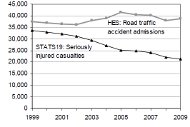9/24/2010
UK Accident Drop Mirrors US PerformanceUnited States matches accident drop in the United Kingdom without using speed cameras.

The UK Department for Transport (DfT) yesterday released statistics that show, like the US, road casualties are falling in Great Britain. DfT officials traditionally use the good news in the nationwide accident numbers to suggest that the use of speed cameras can take credit for the benefits. In this case, the English results showed a 12 percent drop in fatalities and a 4 percent drop in injury accidents from 2008 to 2009. This is nearly identical to the 10 percent drop in fatalities in the US -- which has no speed cameras -- and a 5.5 percent drop in injuries.
When expressed more precisely in terms of the accident rate -- the number of collisions per 100 million vehicle mile traveled -- the US saw a 5 percent drop in all types of crashes whereas Britain saw a 3 percent drop. More detailed examination of the US statistics showed the accident rate was closely related to the unemployment rate on a national and regional basis (read more). DfT's has attributed large casualty reductions directly to the presence of speed cameras.
"The introduction of this caused 69 percent fewer road deaths, 27 percent fewer road accidents and 65 percent fewer speed-related accidents," a DfT summary of the benefits of cameras in West London stated.
The Reported Road Casualties Great Britain 2009 calls into question this figure, as only 5 percent of accidents involved someone exceeding the posted speed limit -- this is the only type of bad driving that can be detected by photo radar units. This statistic is frequently conflated with "traveling too fast for the conditions" which includes crashes, for example on fresh ice where a driver may have been well below the posted limit. The expanded definition accounts for up to 27 percent of fatalities.
"Failed to look properly was again the most frequently reported contributory factor and was reported in 38 per cent of all accidents reported to the police in 2009," the report explained. "Four of the five most frequently reported contributory factors involved driver or rider error or reaction. For fatal accidents the most frequently reported contributory factor was loss of control, which was involved in 36 per cent of fatal accidents."
Traffic calming, including speed bumps and chicanes, caused a total of 196 collisions and 38 serious injury accidents. Transport Secretary Philip Hammond pledged during the election to end the war on the motorist. So far, he has carried out the pledge by withholding central funding for speed camera deployment.


